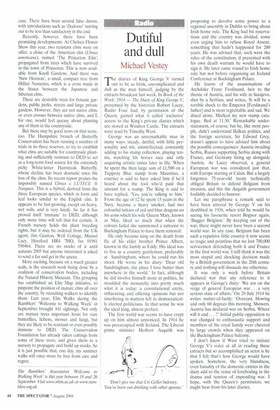Not so DED
Ursula Buchan
re daily walk I take in the countryside oses something of its pleasure in June and July. The sight of numerous small trees in the roadside hedgerows, with their branches rigid and leafless or with sick, yellow foliage, causes me a sharp pang of regret. These young trees are suckers from the roots of dead English elms, Ulmus procera, and the closely related, smooth-leaved elm, Ulmus minor, which survive only until they are mature enough to grow bark, which they do after about ten years. Under the bark bores the elm bark beetle, infecting the tree with the fatal fungus, Dutch elm disease, as it goes.
I am old enough to remember the worstever outbreak of Dutch elm disease in this country, in the early 1970s, of which these hedgerow suckers are sonic of the poor survivors. In the paddock next to our garden in Oxfordshire, there were six fine trees and, as a child, I would lie in bed on summer mornings listening to the rooks cawing raggedly in their tops. One day, a tree surgeon arrived to inject the trees with a fungicide, fruitlessly as it turned out, so he returned to cut them all down. In all, at least 20 million trees died across the country: English and smoothleaved elms in a swathe from Plymouth through the Midlands to East Anglia (including those that Constable had painted in Dedham Vale) and wych elms (Ulmus glabra), which rarely sucker, further north. The landscape changed. The nation mourned. Only in the north of Scotland, thanks to the beetle's dislike of Scotch mist, did mature wych elms survive in any numbers.
Since the 1920s, when there was a lesser outbreak of DED, continuous efforts have been made to find genetically resistant or immune clones, or to breed resistant hybrids, using not only European but Asian and American elm species as well. The Dutch and the Americans have been especially assiduous, the former perhaps stung by being blamed, wrongly, for the spread of the dis ease. There have been several false dawns, with introductions such as cDodoens' turning out to be less than satisfactory in the end.
Recently, however, there have been promising developments. At Chelsea Flower Show this year, two resistant elms were on offer: a clone of the American elm (Ulmus amencana), named The Princeton Elm', propagated from trees which have survived in the town of Princeton. This is now available from Knoll Gardens. And there was 'New Horizon', a small, compact tree from Hillier Nurseries, which is a cross made in the States between the Japanese and Siberian elms.
These are desirable trees for botanic gardens, public parks, streets and large private gardens. However, they are not native elms, or even crosses between native elms, and I, for one, would feel queasy about planting any of them in the countryside.
But there may be good news on that score, too. The Hampshire branch of Butterfly Conservation has been running a number of trials in its three reserves, to try to establish what elms are suitable for countryside planting and sufficiently resistant to DED to act as a long-term food source for the extremely picky White-letter Hairstreak Butterfly, whose decline has been dramatic since the loss of the elms. Its recent report praises the impossibly named Litmus x LUTECE ® Nanguen. This is a hybrid, derived from the three European species, which in loin and leaf looks similar to the English elm. It appears to be fast-growing, except on heavy, wet soils, and is very hardy. So far it has proved itself 'immune' to DED, although only more time will tell that for certain. A French nursery holds the plant breeding rights, but it may be ordered from the UK agent, Jim Oration, Well Cottage, Mansel Lacy, Hereford HR4 7HQ, fax 01981 590464. There are no stocks of it until autumn 2005 but anyone interested is asked to send a fax and get in the queue.
More exciting, because on a much greater scale, is the research work being done by a coalition of conservation bodies, including the Natural History Museum. This grouping has established an Elm Map initiative, to pinpoint the position of mature elms all over the country, by recruiting walkers to identify them. Last year, Elm Walks during the Ramblers' Welcome to Walking Week' in September brought 441 sightings. Not only are mature trees important hosts for rare butterflies, lichens, mosses and fungi, but they are likely to be resistant or even possibly immune to DED. The Conservation Foundation has already taken cuttings from some of these trees, and given them to a nursery to propagate and build up stocks. So it is just possible that, one day, my summer walks will once more be free from care and regret.
The Ramblers' Association Welcome to Walking Week' is this year between 18 and 26 September. Visit www.nrun.acuk or www.ramblers.org.uk



























































 Previous page
Previous page